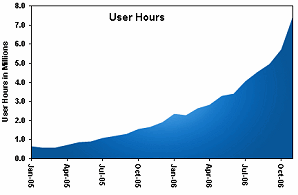I managed to connect to Second Life this morning for the first time in two days.
The virtual world – generally known as the grid – was completely offline since Thursday as developer Linden Lab grappled with a combination of a hardware failure plus database issues.
Downtime due to infrastructure problems have plagued Second Life during the past few weeks, obviously frustrating for the developer and for SL users.
Whatever was the precise cause of the issues that led to the downtime, one thing seems clear – such infrastructure issues are a consequence of growth:
[…] Growth is often a double-edged sword. It is something to celebrate as any world grows and builds communities, allowing more people connect with each other and share hopes and dreams. But growth also poses challenges on how a community can scale, both in the technical and sociological aspects, and often involves some growing pains. I’m sorry for the current database issue, and please know we are working on it.
It brings to my mind similar problems suffered by TypePad and del.icio.us a year ago where growth in demand for their services outpaced the ability of the companies concerned to meet that demand.
Look at SL’s terms of service, especially point 1.6 where you’ll note that there is no guarantee of service. Is that something you simply accept, though? Some people don’t think so:
Unbelievable. A predictable failure that countless startups have had to grapple with. Where is the emergency plan? SL needs to get professional.. it is not a groovy experiment with 100,000 users any longer. This is not supposed to happen with a professionally run service with 2M+ residents. It reminds me of the Tanya Harding incident at the Olympics (the broken shoelace). Does LL want to be taken seriously by business? What are they going to do to get to that point? It’s not going to happen with posts that say “give your First Life a chance!†or “Holiday Support Hours†when there are none to be had.
In Linden Lab’s favour, I’d point to their good communication about what was going on, with regular updating to status posts on the Second Life blog.
While you may not like the news and information you read there, you could not complain at any lack of meaningful communication (unlike the TypePad situation a year ago).
When I first explored Second Life in early February, the total number of registered users was in the low hundred thousands. Now it’s more than two million.
 It’s not such raw numbers that matter, though, it’s how many people are in-world at any one time – it reached a milestone 20,000 users a couple of days ago – the time they spend in Second Life during each visit and what they do there.
It’s not such raw numbers that matter, though, it’s how many people are in-world at any one time – it reached a milestone 20,000 users a couple of days ago – the time they spend in Second Life during each visit and what they do there.
The time-spent number has literally exploded during 2006 as the graph at left indicates.
Linden Lab estimates that about 30% of user hours are spent building and scripting content in-world. That means lots of interaction with the servers and software that run Second Life.
As more people sign up and start using using the service, the demand on the virtual world’s technical infrastructure increases exponentially. If the systems can’t handle it, they’ll fall over as happened this week.
Now I’m not excusing Linden Lab for anything – read again the last quoted comment above – but purely adding a perspective that is worth taking into account.
Until Linden Lab are able to improve the Second Life infrastructure (read: secure more inward investment), it would be prudent to expect more growing pains during 2007.
Related post:












11 responses to “Growing pains for Second Life”
Perhaps SL should start:
1) Limit free memberships until they get their act together.
2) Given premium members a month’s free service for every day users can not
access the service.
3) Notice that the “most popular sites” on SL seldom chances, at least very little
changes in the last 4 months. During peak hours these “lands” are almost
virtually unsuable.
crk
This highlights my big concerns about virtual worlds like Second Life that position themselves as places for people to transact real business with real funds changing hands (at the whim and exchange rates set by the owners, i.e. Linden Labs).
When the “world” is offline, how do people get their money out to use in the real world?
Real world capital markets are governed by credit ratings. You know the creditworthiness of a market by the ratings assigned to it. You can judge the willingness and ability of the market owners (i.e., the sovereign government) to permit the free exchange of capital. What happens in a world like Second Life, where entrepreneurs are alleging that they are making “millions” of Linden Dollars and at some point decide they want to extract that money into real currency?
What if large numbers of people decide to cash out all at one time? It’s a classic run on the bank situation. Where’s the capital market governance? It has the potential to be a virtual Enron.
Access to your money in Second Life is not dependent on the SL grid being up, Steve. You can log in to the LindeX Currency Exchange on the SL website to buy/sell Linden dollars, as well as via a number of other currency exchange websites.
CNN has a good feature about the Second Life currency: How real money works in Second Life.
[…] Growing pains for Second Life […]
Hi, Neville. Thanks for clarifying the delinkage between the currency market and the world itself.
There’s still an issue of what in the real world would be called the “sovereign ceiling,” i.e., the highest creditworthiness rating that could be assigned to the sovereign government based on its ability and willingness to make good on its debts. Unless Linden Labs has contracted with a highly rated financial institution to manage its subscribers’ Linden Dollar accounts, and they have complete flexibility in withdrawing the money any time they decide to do so, then they remain at the mercy of the “sovereign government” or Linden Labs in this case, which can impose currency controls on the export of currency from the market.
When Argentina de-linked from the US dollar several years ago, it caused untold damage to its economy and to holders of peso-denominated deposits. If Linden decided to change the exchange rate or simply decided to limit the amount of money people could extract from SL, it would have a dramatic impact on the SL economy — AND Linden might have very good reasons to limit currency exports, if it runs into a cash flow problem of its own and needs to use the money SL residents keep on deposit.
If you deal with an intermediary institution that doesn’t take currency control instructions from Linden Labs, then you may be all right.
But when I hear about that woman who claims to have earned $1 million by creating real estate space for people in SL, my first reaction is “cash out most of it now.” Pardon me for being skeptical, but when something sounds too good to be true…well, you know where I’m going with that thought!
Well, I’m not an economist, Steve, but I think your points are good ones to raise. Could Linden Lab behave in the way you suggest? I guess they could if the wording of the Second Life terms of use is any guide.
The financial numbers are getting bigger day by day. A stat on the SL website economy page says the total money supply in Second Life amounts to 1,326,496,881 Linden dollars (L$). At yesterday’s best selling rate of L$277 = US$1.00, that’s equivalent to nearly 4.8 million US dollars.
Nearly a million US dollars changed hands yesterday in actual transactions, according to the little status window in my SL desktop application. A similar figure the day before and in many other preceding days.
That’s a lot of money for what some people just call a game.
Clearly “money” is changing hands in SL. The key question is whether Linden will exercise its sovereignty and change the rules of the game. I haven’t read their TOS, but I suspect it pretty much would be a proxy for a sovereign government’s monetary policy. Any sovereign can decide to impose currency controls, and if this happens in the real world it causes financial dislocation, but people do have recourse to get their money out. This is a lot like having all your eggs in the Enron 401(k). You have no recourse if they decide to deflate the Linden Dollar, or inflate it, or simply limit the amount you can actually convert into real world currency.
I wonder what the real world rating agencies would have to say about the sovereign ceiling of second line?
[…] Last week, I wrote about Second Life’s growing pains with a conclusion that the combination of more users doing more things when online, and staying online longer on each visit, will likely lead to more grid downtime (such as the 2-day outage ten days ago) unless developer Linden Lab is able to scale the infrastructure – the servers and systems – on which Second Life runs to keep pace with and support the virtual world’s continuing growth. […]
Steve, the points you raise re monetary controls are good ones.
I wonder what any of the big companies who’ve established a presence in SL – and some have invested more than just time and imagination – think of that.
What discussions might they have had with Linden Lab? What would they think of the points you raise as they continue their plans to further develop their long term presence?
More questions than answers at the moment.
Everyone who is sinking real $$ into the fictitious currency at SL ought to read carefully this article from the December 18 issue of Information Week magazine:
http://www.informationweek.com/news/showArticle.jhtml?articleID=196604327
It’s about Linden Labs taking control of what a subscriber thought was his own intellectual property and the lawsuit that’s wending its way through the courts. Significantly, and very negative for the kind of transparency a global capital market needs, Linden Labs declined to comment for the story. As the sovereign government with the power to control its currency exchange, LL has an obligation to investors to disclose how it intends to manage monetary policy. If it is unwilling to be specific about what you and other SL participants own, be scared, be very very scared, for the money you’ve sunk there.
I challenge anyone who claims to have made large sums of money in SL to actually exchange that money for real US Dollars in a large transaction. See if you can actually pull out $100,000 in a single move, or if they limit you to $30 or $40 a month.
[…] Growing pains for Second Life […]